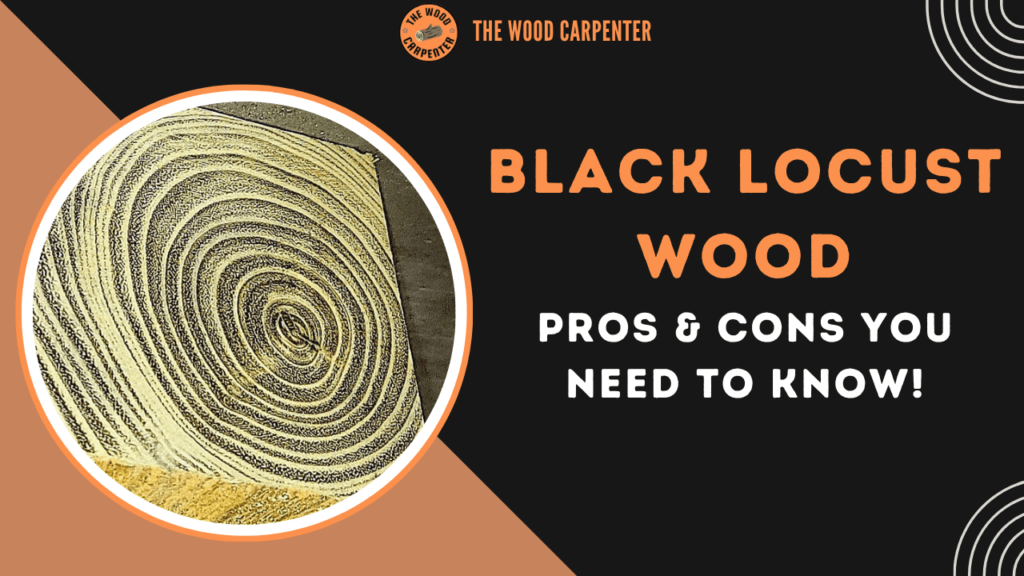
What Is Black Locust Wood?
Black locust wood comes from the Robinia pseudoacacia tree. It is known for being very strong, long-lasting, and naturally resistant to rot and bugs. Because of these great qualities, it is popular among woodworkers, builders, and people who care about the environment.
This wood is used for many purposes—both practical and decorative. In this easy guide, you’ll learn about its features, how it’s used, its eco-friendly benefits, and why it’s great for modern green building.
Where Does It Come From?
Black locust wood comes from the black locust tree. This tree grows quickly and is very tough. It originally grew in the Appalachian region of the United States but is now found across North America, Europe, and Asia. The tree can grow as tall as 40 to 100 feet, and some can get even taller.
What Does the Wood Look Like?
The wood has a straight, tight grain and feels medium to rough to the touch. Its color can range from light greenish-yellow to deep brown, and it gets darker as it gets older.
Key Characteristics
1. Long-Lasting and Rot-Resistant
Black locust is one of the most rot-resistant types of wood found in North America. It’s perfect for outdoor use, like fence posts and decks. It doesn’t need chemical treatments and can last for decades—sometimes over 100 years!
2. Strong and Hard
Black locust is very strong and hard. It has a Janka hardness of 1,700 lbf, which means it’s harder than many types of oak and hickory. Because of this strength, it’s great for heavy-duty jobs like building bridges or railroad tracks.
3. Naturally Insect-Resistant
This wood keeps termites and other bugs away without needing chemical sprays or treatments. That makes it safer and easier to use.
4. Can Be Hard to Work With
Black locust is dense and tough, which makes it harder to cut or shape with hand tools. However, it works well on a lathe or when using steam bending. To cut it properly, you need very sharp tools—carbide tools are best.
5. Eco-Friendly and Sustainable
Black locust trees grow quickly and are not endangered. They’re a good alternative to tropical hardwoods, making them a smart choice for people who care about the environment.
Common Uses of Black Locust Wood
Black locust wood’s unique combination of strength, durability, and beauty makes it suitable for a wide range of applications:
Fencing and Outdoor Structures: Its resistance to rot and insects makes it a top choice for fence posts, rails, and outdoor furniture.
Decking and Boardwalks: Black locust decking is prized because for its longevity and slip resistance, often outlasting pressure-treated pine by decades.
Boatbuilding and Marine Applications: The wood’s resistance to water and rot has made it a favorite for shipwrights and boatbuilders for centuries.
Furniture and Flooring: Its attractive grain and rich color make it a popular choice for high-end furniture and flooring, especially in rustic or outdoor settings.
Mine Timbers and Railroad Ties: Black locust’s strength and durability are ideal for heavy-duty applications such as mine timbers and railroad ties.
Firewood: Black locust burns slowly, with a high heat output and minimal smoke, making it excellent for wood-burning stoves.
Environmental Benefits
Black locust trees offer significant ecological advantages:
Nitrogen Fixation: Black locust is a nitrogen-fixing tree, it enriches the soil and improving fertility for surrounding plants.
Erosion Control: Its extensive root system stabilizes soil, making it effective for erosion control and land restoration.
Reduced Chemical Use: The wood’s natural resistance to decay and pests means it requires fewer chemical treatments, supporting eco-friendly building practices.
Carbon Sequestration: Fast growth and dense wood make black locust an effective carbon sink, contributing to climate change mitigation.
Working with Black Locust Wood
Advantages of Black Locust Wood
1. Very Long-Lasting
Black locust wood can last anywhere from 50 to over 100 years outdoors—even without using any chemicals. That makes it a great choice for things like decks, fences, and outdoor furniture.
2. Looks Better Over Time
As it gets older, black locust wood develops a beautiful, rich color (called a patina). This makes it look even better with age, especially on furniture and decking.
3. Eco-Friendly
Black locust trees grow fast and are a renewable resource. Since they don’t need much care or chemical treatment, they are a great option for people who want to build in an environmentally friendly way.
Ash Wood: Discover Its Secrets !
Sassafras Wood: More Than Just Timber !
Challenges of Black Locust Wood
1. Hard to Work With
The wood is very dense and hard, which means it’s not easy to cut or shape. You’ll need sharp tools and some experience to work with it properly.
2. Can Splinter Easily
Black locust can splinter while being cut or finished. This means you need to be extra careful during the building process to avoid rough edges or injuries.
3. Possible Skin or Eye Irritation
In rare cases, black locust can cause skin or eye irritation in sensitive people. Also, the seeds and bark are toxic if eaten, so it’s important to handle it with care—especially around children and pets.
4. Price Can Vary
In areas where black locust trees grow naturally, the wood is affordable. But in places where it has to be shipped in, it can cost more than other types of wood.
Comparison with Other Hardwoods
| Feature | Black Locust | Oak | Hickory |
| Janka Hardness | 1,700 lbf | 1,290–1,360 lbf | 1,820 lbf |
| Rot Resistance | Excellent | Good | Moderate |
| Insect Resistance | Excellent | Good | Moderate |
| Workability | Challenging | Moderate | Challenging |
| Sustainability | High | Moderate | Moderate |
Sustainability and Certification
Black locust is a great eco-friendly wood choice. It’s not endangered and grows in many parts of North America and Europe. The trees grow quickly and can even regrow from their roots, making them a renewable and sustainable source of timber.
Some companies offer FSC-certified black locust wood. This means the wood comes from the forests that are managed in a responsible & in a environmentally friendly way.
Black Locust in Modern Building
Today, black locust is becoming more popular in green and eco-friendly construction. Because it naturally resists rot and insects, there’s no need to treat it with harmful chemicals. This makes it a safer and more earth-friendly alternative to pressure-treated wood.
Builders and architects like black locust for its strength, long life, and beautiful look. It’s used for many things, including:
- Decking
- Fencing
- Outdoor furniture
- Garden beds
- Structural beams
Its mix of beauty and durability makes it a top choice for modern, sustainable buildings.
Black Locust Wood: Myths and Facts
Myth: Black locust and honey locust are the same.
Fact: Even though their names sound alike, black locust and honey locust are different trees with different features.
Myth: Black locust wood is hard to take care of.
Fact: Black locust wood is easy to maintain because it naturally resists rot and bugs.
Myth: Black locust is poisonous to everyone.
Fact: Some parts of the black locust tree are poisonous if eaten, but most people will not get seriously sick unless they eat a lot.
Frequently Asked Questions
1. What is black locust wood used for?
It is used for fencing, decking, outdoor furniture, boatbuilding, flooring, mine timbers and railroad ties due to its strength and durability.
2. How long does black locust wood last outdoors?
Black locust can last 50 to 100 years or more outdoors without chemical treatment.
3. Is black locust wood expensive?
Prices vary by region. It is generally affordable within its native range but can be more expensive where imported.
4. Is black locust wood eco-friendly?
Yes, black locust is a fast-growing, renewable resource that requires minimal chemical treatment and is often FSC-certified.
5. Can black locust wood be used for indoor furniture?
Yes, its attractive grain and color make it suitable for indoor furniture, though it is most commonly used outdoors.
6. Is black locust wood resistant to insects?
Yes, black locust is naturally resistant to the termites and other wood-boring insects.
7. How does black locust compare to oak?
Black locust is harder and more rot-resistant than most oaks, making it better suited for outdoor applications.
8. Is black locust wood toxic?
Parts of the tree, especially seeds and bark, are toxic if ingested, but severe reactions are rare.
9. Can black locust wood be used for firewood?
Yes, black locust is an excellent firewood, burning slowly with high heat output and minimal smoke.
10. How does black locust benefit the environment?
Black locust trees fix nitrogen, stabilize soil, prevent erosion, and require fewer chemicals, making them beneficial for ecosystem health.
Final Thoughts
Black locust wood are one of the strongest, longest-lasting, and most eco-friendly hardwoods you can find today. It naturally resists rot and insects, needs very little upkeep, and works great for outdoor projects and heavy-duty use.
But it’s not just useful—black locust trees also help the environment. They improve soil, prevent erosion, and absorb carbon from the air, making them good for the planet.
Whether you’re a builder, a woodworker, or someone who cares about using sustainable materials, black locust is a smart and green choice. With the right care, it can last for decades—even over 100 years—making it a reliable investment for any project.

